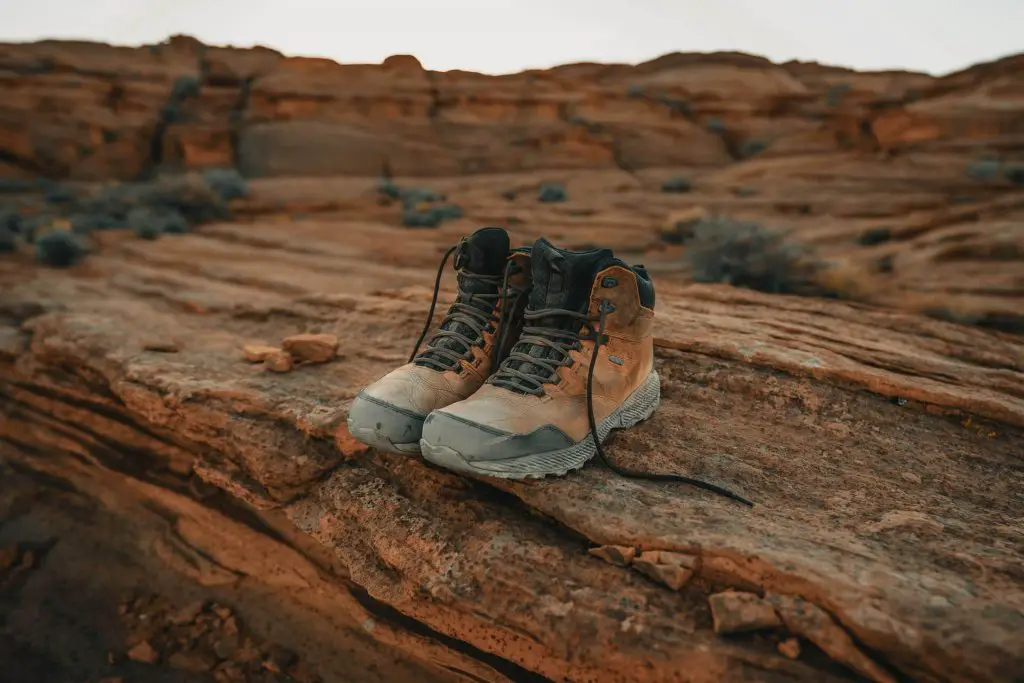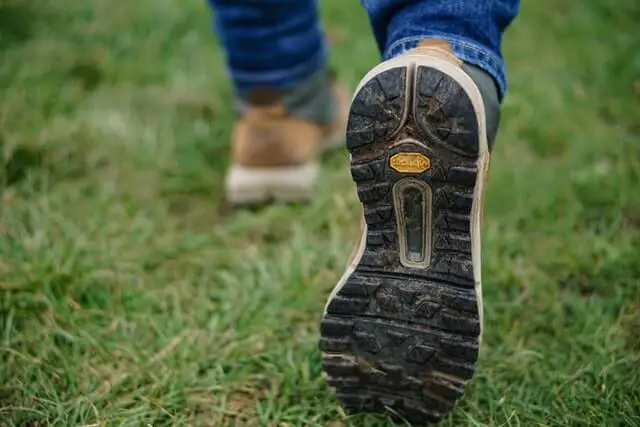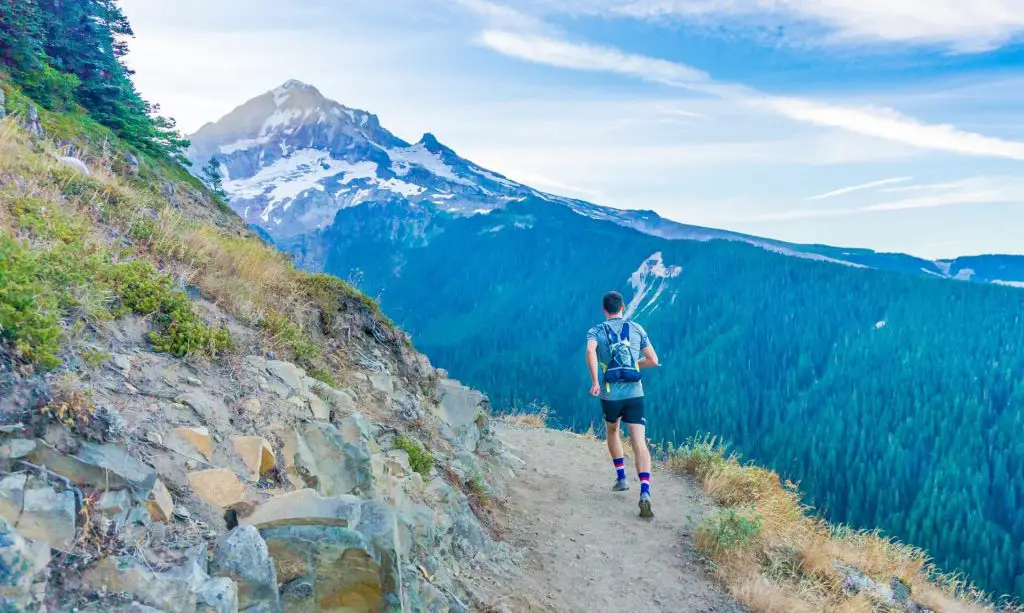
Hiking on the dirt trails, massive boulders, across streams, along mountain ridges, and on top of slick granite is always a fun journey, but do you really need hiking boots to safely enjoy all of this?
Hiking can take you across a variety of terrain and to the most beautiful natural sights, but you don’t really need hiking boots for your hikes. However, finding the right hiking boots or trail shoes can be the difference between a comfortable and relaxing hike or a slow painful endeavor on your next hike.
I started hiking more than a decade ago and my first hikes were in my beat-up running shoes that clearly needed to be replaced. Despite my old shoes, I was able to make my way up hundreds of switchbacks, across small streams, scramble up slippery boulders, and so many other miles of terrain. Although I was able to make it through these various obstacles, I wish I had bought my hiking boots much sooner. There are many great benefits of hiking boots you should consider that can make your hikes more enjoyable and safer.
Main considerations For Deciding on Hiking Boots or Shoes
Trail Distance
While your non-hiking boots can likely take you on a variety of hikes, one of the most key considerations to think about is how long will your next hike be? My running shoes were able to make it on short local hikes ranging from one mile to four miles, but the moment I took them out on five miles or longer that is when I realized I wish I had better shoes.
Any discomfort or feet sliding in your shoes will be exasperated over long hikes which can lead to blisters and incredibly sore feet. Hiking boots will provide you with stable footing, foot protection, and breathability. This will make it so you don’t even notice anything about your feet during the duration of your hike. When wearing my old running shoes I would notice every large rock I stepped on or every rub of my shoe on my ankles while going up and down the switchbacks. So before you head out on your next hike, consider if your shoes will be able to provide you with enough comfort and stability for that trail distance.
Terrain
The next important consideration is the terrain of your upcoming hike. If you are able to find detailed information about your hike regarding sand, water streams, rocky trails, scrambling, and other obstacles, then you want to help your feet be prepared as much as possible with the proper shoes. By knowing the major terrain obstacles on your next hike then you can determine how much traction you will need to be able to hike safely.
Having good trail shoes or hiking boots with good traction can help prevent hiking accidents or twisting your ankle on a slippery granite top. Your normal shoes may perform admirably on local trails that are well paved, but if you plan on expanding to trails with a greater variety of terrain, then think about if you have enough traction for your next hiking trail.
Weather and Water
Another important factor to consider for choosing between shoes and hiking boots is what the upcoming weather will be or if you have to cross a flowing body of water. If you have rain in your forecast or you have to cross flowing water and your shoes are not waterproof then you will be in for a long hike. Hiking with wet feet is a recipe for bad blisters.
Once normal shoes are wet they will likely take hours to dry off in ideal conditions and your feet will be soaked for the duration of your hike. It is very important to have waterproof shoes to protect your feet from getting wet, so check the weather and if there are any water crossings before you head out on your next hike.
Why do people buy hiking boots?

Traction
One of the main differences between hiking boots and normal shoes is the traction that hiking boots provide. Hiking boots get their traction from the rubber bumps on the bottom of the shoe called lugs. The lugs provide hikers with better grip and traction on a variety of surfaces. The lugs will help lower the chances of slipping on slippery boulders or sandy surfaces.
When hiking on dirt paths the traction lack of traction is not noticeable for normal shoes, but once you take those shoes on more challenging terrain then you will notice you slip more and can lose your balance. The lugs on hiking boots help give you peace of mind by providing more traction so you are safer during your hikes.
Ankle Support
If you are looking at hiking boots with mid or high tops then they will provide excellent ankle support. The tops of the boots will prevent your ankles from twisting too far if you accidentally slip or have a misstep. This is very noticeable if you are backpacking with a large pack on your back and you take a misstep as the top of the hiking boot will keep your ankle from bending too far.
If you are hiking with normal shoes without ankle protection then you can badly twist your ankle when out on the trails. The combination of the increased traction and the ankle support of hiking boots will decrease the odds of bad ankle or foot injuries.
Durability
Hiking boots are designed to be beaten up on the mountains, across streams, and in very tough conditions. Most hiking boots from reputable brands will live up to the challenge and keep your feet warm, protected, and dry thanks to the high-quality materials and build of the shoe.
As you hike to many different places the hiking boots will remain durable and protect your feet. Hiking shoes on average are estimated to last between 500 and 900 miles.
What are alternatives to hiking boots?

If you want the traction and durability of hiking boots, but don’t want to wear such a heavy shoe or are worried about ankle protection, there are three main alternatives you can consider that still offer many of the great benefits of hiking boots.
Trail Runners
The first on this list are trail runners. Trail runners are designed to give hikers the benefit of great traction so you can even run quickly on hiking trails. Another benefit of trail runners is they are generally significantly lighter than hiking boots, so you can burn less energy on each step you take. Trail runners also provide the same benefit of breathability.
With trail runners, the main downside to them is that they do not provide ankle protection as they want to allow the wearer more quick movements, so keep this in mind if you are considering trail runners.
Low-top Hiking Boots
Another alternative to mid or high-top hiking boots is low-top hiking boots. I started my hiking journey using low-top hiking boots as they were a bit cheaper. They provide the great benefits of traction, durability, breathability, and stability. If your feet get hot but you like the feel of hiking boots, then these are a great choice. Again the only downside here is the lack of ankle support.
Hiking Sandals
Probably the most extreme divergence from hiking boots is hiking sandals. These have grown in popularity over the years as they can provide great traction, the best breathability, and are the most lightweight out of all of the options. Another added benefit of hiking sandals is that even if your feet get wet they will quickly dry. One of the biggest downsides of hiking sandals is if you are hiking in cold weather then your feet will be freezing!
Summary
Although hiking boots are not necessary for your next hike, it is hard to ignore the many benefits of hiking boots that they provide. My world was flipped upside down when I switched from regular running shoes to hiking boots. On my first long hike that is when the light bulb went off and I noticed just how much more comfortable and relaxing my hike was.
Hiking boots will provide you with greater traction, stability, ankle support, and durability so you can be safer on all of your upcoming hikes. The next time you are deciding between your shoes or hiking boots just think about the trail distance, terrain obstacles, and weather. There is no one size fits all strategy, so adapt your footwear after each adventure and reevaluate as the years go on.
